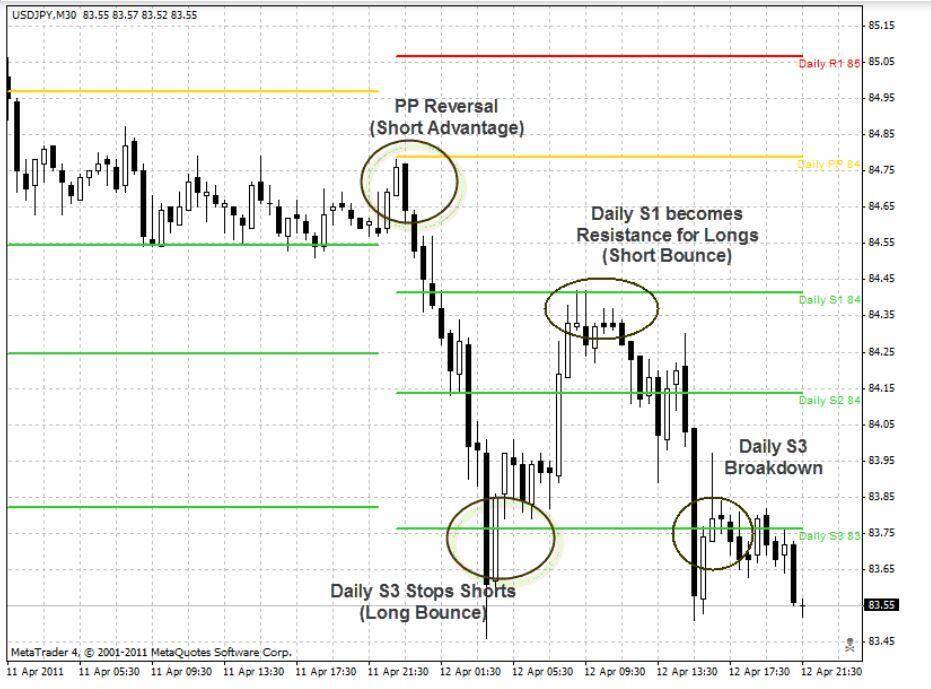
Having a grasp of the market’s general direction means you would be able to bounce trades off the Pivot Point (PP). This is in consideration of the direction the market took relative to it at the day’s opening.
Looked to as a major arbiter of the market’s movements, the PP is a well-known Technical Analysis indicator. The market is said to be Bullish if it opens above the PP. If it’s below it, then it Bearish.
Should the Currency Pair go into contact with the PP and reverses afterward, the level is said to be stronger. Put, Pivoting means being able to reach either a support or resistance level then reversing shortly after.
When you use the PP as a basis for market direction, try a Bounce Trade. Do this when the market retests the PP.
The Rules of Entry and Exit
In the chart below are specifics of the conditions that a trader must take note of when considering Entrances and Exits in Long and Short trades in consideration of the PP, the Stop Loss, and Take Profit.
| Rules of Entry & Exit | Long | Short |
| Entry | Buy at or near the PP line should the price start above it. It has to be with the market or limit order. Should the PP be missed as market advances stand strong, an alternate trade can still be seen in the long-biased direction. Should the market be stopped at R1 or R2 and then goes back to the PP, it is advised to take a long trade from a PP bounce. | Entails selling at or near the PP line requires with market or limit order. Should the PP be missed, and the market plummets, an alternate trade can still be seen in the short-biased direction. Should the market be stopped at R1 or R2 then springs back to the PP, it is advised to take a short trade from a PP bounce. |
| Conservative Entry | The market touching the line is something that you would want to see. It is also advised that you take a trade only when the market closes x pips above the PP level. This strongly suggests that the line held on strong. | Same with Long |
| Stop Loss | For greater trade leeway, you might want to establish SL a few pips below the PP or S1. | The SL is a few pips above PP R1 gives more wiggle room. |
| Take Profit | The TP at S2. Should you see that it reaches S1, move SL to breakeven | Plant TP at R2. Should the price reach R1, move SL to breakeven. |
For Greater Understanding
To understand it more clearly, here is an example. This is taken from the Daily Pivot levels back in April 2011. Sampled here is the currency pair USD/JPY.

The chart illustrates a market that had just commenced beneath the PP. It has a short bias for the day. The first bar kisses the PP. Just beside it is the level that had been touched. This can be seen through the formation of a candlestick, indicating a Bearish nature.
There, you can see that the market plummeted from the PP level through the S1 and S2.
Should you have taken the aggressive road, placing your chance on the short trade close to the PP while watching the Bearish candlestick closely, you would have arrived at this trade. It would help if you had also been awake and vigilant until the stroke of midnight when the bar opened, as this would allow you to catch the opportunity.
As you can see through the chart, the Bulls staged a sizeable counterattack at S3 as it pushed the market to retest at S1.
Even if you had missed the first bounce at PP, the second could be found through taking a short bounce at S1. As the Pivot stood strong in the early parts of the short biased day, it became the resistance. The Bearish bouncers took their stead at S1 to resist their S3 counterparts. Successful at their attempt, the 2 bars that had kissed the S1 had gone on to form candlesticks of Bearish nature.
How to interpret them:
In the chart, what the long upper shadow means is that the Bulls were in control for a period. However, it lost control towards the end. This also meant that the bears had been able to resume control.
Do note that through observation of the candlestick’s behavior after the level’s initial touch, one can derive insight into which exactly controls the trade. The intra-session low says that the game is bearish while the intra-session high says the Bulls dominate. When the close inches to the high, the Bulls get the upper hand, if low, then the bears have it.
Watch Out for Risks When Bouncing from Pivot
While taking a bounce trade from the Pivot does have its advantage, the Pivot proves to be a contested line. It is difficult to break the line when either the Bulls or the Bears are on the other side of the Pivot. As such, you have to be vigilant in determining a break. Further, one is advised to be cautious and make use of the bounce only when the candlesticks seem to be forming post the kiss on the Pivot.




